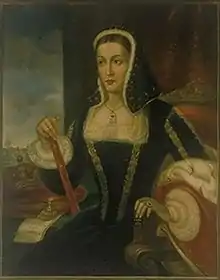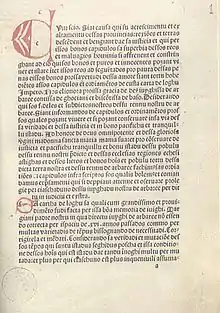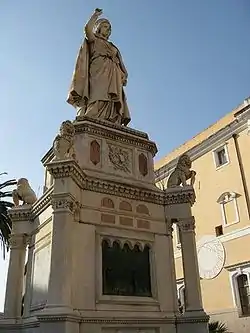Eleanor of Arborea
Eleanora or Eleanor of Arborea (Sardinian: Elianora de Arbaree,[1] Italian: Eleonora d'Arborea, &c.; 1347—1404) was one of the most powerful and important, and one of the last, judges of Sardinia, and Sardinia's most famous heroine.[2]

(portrait of fantasy, A. Caboni 1881)
Biography


When Judge Pietro III of Arborea died without descendants in 1347, the Crown de Logu of the Judged (an assembly of notables, prelates, and officials of the towns and villages) elected the father of Eleanor (Marianus IV of Arborea, brother of the deceased), who held his brother’s old post from 1347 to 1376.[3]
Eleanor was born at Molins de Rei.[4] Recent studies, based on a letter from Aymeric VI of Narbonne, husband of Beatrice, to King Peter IV of Aragon, in which he claimed the Arboreal throne for son Guglielmo I (Royal Archives of Barcelona), immediately after the death of Ugone III, ascertain that she was the third child of Marianus IV and Timbora.[5]
She was married off to Brancaleone Doria, for the sake of an alliance between the Doria and Arborea families.[6]
She obtained her judgeship in 1383 when her brother Ugone and his daughter were killed in a conspiracy.[6]
In 1392 Eleanor granted for the first time in history the protection of bird nests against illegal hunters under the jurisdiction later conferred by the Carta de Logu; the Eleonora's falcon (Falco eleonorae) was later named after her due to this.[7][8] She herself, as well as her other family members, enjoyed falconry.[9]
She enacted the code of laws known as the Carta de Logu (meaning Charter of Law), which was in effect in Sardinia from 1395 until 1827.[10] In that code there is the modernizing of certain norms and the juridical wisdom that contains elements of the Roman-canonical tradition, the Byzantine one, the Bolognese jurisprudence and the thought of the glossators of the Catalan court culture, but above all the local juridical elaboration of the Sardinian customs made by Sardinian municipal law.[11] One notable provision of the Code is that it gave daughters and sons the same inheritance rights.[12] As well, it also declared that rape could be recompensed through marriage only if the woman who was raped agreed to marry her rapist, and even if she did the Code declared that the rapist still had to either pay a large fine to the Senate or have his foot cut off (his choice).[13] If she did not agree to marry him, he had to give her a dowry that suited her social status, so that she could marry someone else, and he still had to either pay a large fine to the Senate or have his foot cut off (his choice).[13] As well, these punishments were not affected by whether or not the woman in question was betrothed.[13] The Code also led Eleanor to be remembered as one of the first lawmakers to set up the condition of reciprocity when dealing with foreigners, as well as the crime of misfeasance.[14]
Eleanor died of plague in 1404, and Arborea slowly fell into decline due to her death.[14]
Tributes
The scholar Francesco Cesare Casula identified, in the church of San Gavino Monreale, a few miles from the castle of Monreale in Sardara, the high reliefs representing the only contemporary portraits of Eleanor, Marianus IV, Ugone III and Brancaleone Doria.[15]
There is a statue of Eleanor in the Piazza Eleonora in Oristano.[16]
References
- Carta de Logu
- "Donne di Firenze. / Broadsides and Ephemera Collection / Duke Digital Repository". Repository.duke.edu. Retrieved 2018-07-01.
- Bianca Pitzorno, Life of Eleonora d'Arborea, medieval princess of Sardinia, pg. 12, Mondadori, Milan 2010, ISBN 978-88-04-59714-8 .
- Francesco Cesare Casula, Eleonora queen of the kingdom of Arborea, pg.20, Carlo Delfino, Sassari 2002.
- "Biographical Dictionary of Italians", volume 70/2007
- Virginia Lalli (February 2014). Women in Law. Author House. pp. 12–. ISBN 978-1-4918-6454-8.
- Charta de Logu Elianora de Arbarèe Capitulos 81-100, Capitulu 87 - De astores
- Natura Mediterraneo, Il falco della regina - Falco eleonorae
- Virginia Lalli (February 2014). Women in Law. Author House. pp. 11–. ISBN 978-1-4918-6454-8.
- Virginia Lalli (February 2014). Women in Law. Author House. pp. 11–. ISBN 978-1-4918-6454-8.
- Raimondo Carta Raspi, Mariano IV of Arborea, Il Nuraghe, Cagliari 1934. Raimondo Carta Raspi, History of Sardinia, Mursia, Milan 1981.
- Virginia Lalli (February 2014). Women in Law. Author House. pp. 16–. ISBN 978-1-4918-6454-8.
- Virginia Lalli (February 2014). Women in Law. Author House. pp. 17–. ISBN 978-1-4918-6454-8.
- Virginia Lalli (February 2014). Women in Law. Author House. pp. 18–. ISBN 978-1-4918-6454-8.
- Giuseppe Spiga, Guide to the "Pantheon" of the Arborea in San Gavino Monreale, pg. 34, Carlo Delfino, Sassari 1992.
- Editors of the American Heritage Dictionaries (2005). The Riverside Dictionary of Biography. Houghton Mifflin Harcourt. pp. 257–. ISBN 0-618-49337-9.CS1 maint: extra text: authors list (link)
Further reading
- Caravale, Mario (ed). Dizionario Biografico degli Italiani LXII Dugoni – Enza. Rome, 1993.
- Carta de Logu 15th century Incunable. http://www.sardegnacultura.it/documenti/7_88_20070215114729.pdf
- Lupinu, Giovanni. Carta de Logu dell'Arborea, Nuova edizione critica secondo il manoscritto di Cagliari. Centro di Studi Filologici Sardi. 2010. ISBN 9788895701219
- Manno, Giuseppe (1835). Storia di Sardegna. P.M. Visaj.
- Mearns, Barbara and Richard. Biographies for Birdwatchers. ISBN 0-12-487422-3
- Onnis, Omar; Mureddu, Manuelle (2019). Illustres. Vita, morte e miracoli di quaranta personalità sarde (in Italian). Sestu: Domus de Janas. ISBN 978-88-97084-90-7. OCLC 1124656644.
- Pitzorno, Bianca, Vita di Eleonora d'Arborea, Mondadori, Milan 2010.
| Preceded by Hugh III |
Judge of Arborea 1383 – 1404 |
Succeeded by Marianus V |